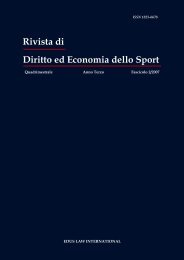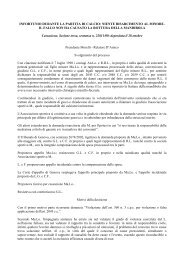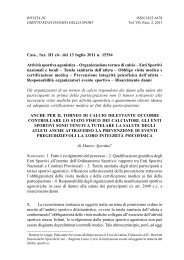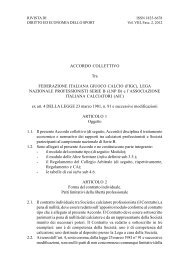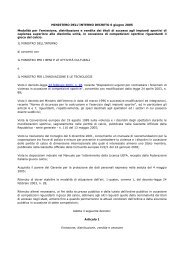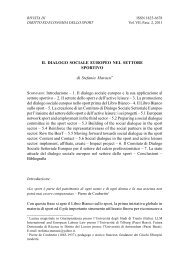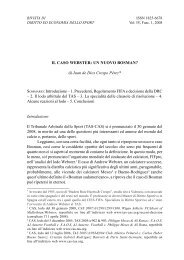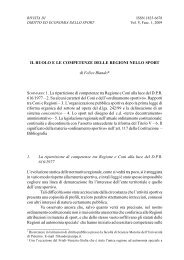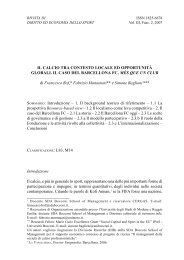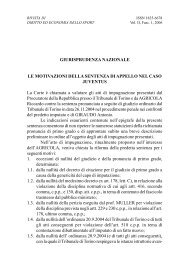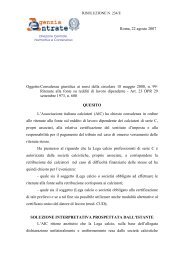Create successful ePaper yourself
Turn your PDF publications into a flip-book with our unique Google optimized e-Paper software.
Globalization of the sports economy 21<br />
internationally transferred – from a club in one country to a club located abroad.<br />
International transfers of football players skyrocketed in this global labour market<br />
since <strong>it</strong> was entirely de-regulated by the Bosman case in 1995. The latter was<br />
followed up w<strong>it</strong>h Malaja, Kolpak and Simutenkov cases, as well as the Cotonou<br />
agreement signed between the EU and 77 Asian-Caribbean-Pacific countries, which<br />
extended the globalization of labour market to other sports than football and to<br />
various areas of the world economy. Football has of late recently become the most<br />
investigated global market in the sports economy, given rising concerns over the<br />
transfer of teenagers players below the age of 18; which brought about new research<br />
in the 2000s.<br />
The transfers of teenage players is illegal and is undertaken under outrageous<br />
and infamous cond<strong>it</strong>ions offered to young players. 16 The increasing turnover in the<br />
labour force and the growing international mobil<strong>it</strong>y of athletes continues to be felt<br />
and annually destabilizes the manpower of many sport teams, w<strong>it</strong>h the exception<br />
of the richest. Such consequences of free movement in a global market call for the<br />
re introduction of certain regulations. 17 The ultimate consequence in some countries<br />
could see domestic sports losing <strong>it</strong>s control as a result of the transfer balance (the<br />
difference between players transferred abroad and those transferred from abroad)<br />
as happened in French professional football in the early 2000s.<br />
Another outcome is the emergence of an underground (black) market for<br />
teenage players after the introduction of new FIFA regulations released in 2001.<br />
These regulations prohib<strong>it</strong> the transfer of players below the age of 18. An alternative<br />
regulation, suggested to be spread to all sports, not only football, has been designed<br />
following the model of a Tobin tax on short term international cap<strong>it</strong>al movements<br />
(which are typical of financial globalization).<br />
Coined as the “Coubertobin” tax, 18 this proposed new regulation is<br />
conceived in such a way as to curb on international player mobil<strong>it</strong>y as a function of<br />
age when international transfes are effected (namely, the younger the age of the<br />
player transferred the higher the tax rate due from the transfer). Tax revenues<br />
would accrue an international fund for sport development in developing countries<br />
where teenage players have been discovered, trained and educated. Introducing<br />
such a tax is not envisaged so far, but <strong>it</strong> would be meaningless to adopt the tax<br />
w<strong>it</strong>hout a tighter supervision of the activ<strong>it</strong>ies of player´s agents. Most player´s<br />
agents involved in international transfers are not even registered at the FIFA or<br />
____________________<br />
16<br />
TSHIMANGA, E. BAKADIABABU, Le commerce et la tra<strong>it</strong>e des footballeurs africains et sud-américains<br />
en Europe, L’Harmattan. Paris, 2001.<br />
17<br />
The most publicised call is the one by Mr. Sepp Blatter (a former UEFA top manager) in favour<br />
of a so-called 6 + 5 rule, meaning that any football team must field a squad w<strong>it</strong>h six native of the<br />
domestic country and no more than five foreign players. However, such regulation contradicts<br />
the Bosman jurisprudence and has no chance to be implemented against the law (the Treaty of<br />
Rome article which guarantees international labour mobil<strong>it</strong>y to all EU c<strong>it</strong>izens). Something more<br />
sophisticated is to be thought of.<br />
18<br />
W. ANDREFF, The taxation of player moves from developing countries, in R. Fort, J. Fizel,<br />
(eds.), International Sports Economics Comparisons, Prager, Westport, CT, 2004, 87-103.



